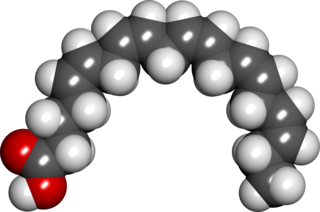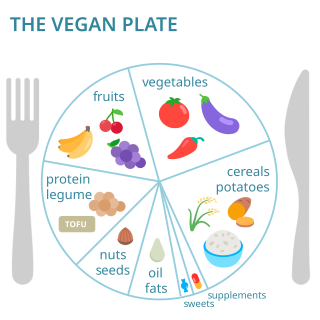Related Research Articles
Omega−3 fatty acids, also called omega−3 oils, ω−3 fatty acids or n−3 fatty acids, are polyunsaturated fatty acids (PUFAs) characterized by the presence of a double bond three atoms away from the terminal methyl group in their chemical structure. They are widely distributed in nature, being important constituents of animal lipid metabolism, and they play an important role in the human diet and in human physiology. The three types of omega−3 fatty acids involved in human physiology are α-linolenic acid (ALA), eicosapentaenoic acid (EPA) and docosahexaenoic acid (DHA). ALA can be found in plants, while DHA and EPA are found in algae and fish. Marine algae and phytoplankton are primary sources of omega−3 fatty acids. DHA and EPA accumulate in fish that eat these algae. Common sources of plant oils containing ALA include walnuts, edible seeds, and flaxseeds as well as hempseed oil, while sources of EPA and DHA include fish and fish oils, and algae oil.

Infant formula, also called baby formula, simply formula, baby milk or infant milk, is designed and marketed for feeding to babies and infants under 12 months of age, usually prepared for bottle-feeding or cup-feeding from powder or liquid. The U.S. Federal Food, Drug, and Cosmetic Act (FFDCA) defines infant formula as "a food which purports to be or is represented for special dietary use solely as a food for infants by reason of its simulation of human milk or its suitability as a complete or partial substitute for human milk".

A dietary supplement is a manufactured product intended to supplement a person's diet by taking a pill, capsule, tablet, powder, or liquid. A supplement can provide nutrients either extracted from food sources, or that are synthetic. The classes of nutrient compounds in supplements include vitamins, minerals, fiber, fatty acids, and amino acids. Dietary supplements can also contain substances that have not been confirmed as being essential to life, and so are not nutrients per se, but are marketed as having a beneficial biological effect, such as plant pigments or polyphenols. Animals can also be a source of supplement ingredients, such as collagen from chickens or fish for example. These are also sold individually and in combination, and may be combined with nutrient ingredients. The European Commission has also established harmonized rules to help insure that food supplements are safe and appropriately labeled.
Essential fatty acids, or EFAs, are fatty acids that are required by humans and other animals for normal physiological function that cannot be synthesized in the body. As they are not synthesized in the body, the essential fatty acids – alpha-linolenic acid (ALA) and linoleic acid – must be obtained from food or from a dietary supplement. Essential fatty acids are needed for various cellular metabolic processes and for the maintenance and function of tissues and organs. These fatty acids also are precursors to vitamins, cofactors, and derivatives, including prostaglandins, leukotrienes, thromboxanes, lipoxins, and others.

Chlorella is a genus of about thirteen species of single-celled green algae of the division Chlorophyta. The cells are spherical in shape, about 2 to 10 μm in diameter, and are without flagella. Their chloroplasts contain the green photosynthetic pigments chlorophyll-a and -b. In ideal conditions cells of Chlorella multiply rapidly, requiring only carbon dioxide, water, sunlight, and a small amount of minerals to reproduce.
A boycott was launched in the United States on July 4, 1977, against the Swiss-based multinational food and drink processing corporation Nestlé. The boycott expanded into Europe in the early 1980s and was prompted by concerns about Nestlé's aggressive marketing of infant formulas, particularly in underdeveloped countries. The boycott has been cancelled and renewed because of the business practices of Nestlé and other substitute manufacturers monitored by the International Baby Food Action Network (IBFAN). Organizers of the boycott as well as public health researchers and experts consider breast milk to be the best nutrition source for infants. The World Health Organization (WHO) recommends infants to be exclusively breastfed for the first six months of their lives, nevertheless, sometimes nutritional gaps need to be filled if breastfeeding is not possible.
Fish oil is oil derived from the tissues of oily fish. Fish oils contain the omega−3 fatty acids eicosapentaenoic acid (EPA) and docosahexaenoic acid (DHA), precursors of certain eicosanoids that are known to reduce inflammation in the body and improve hypertriglyceridemia. There has been a great deal of controversy in the 21st century about the role of fish oil in cardiovascular disease, with recent meta-analyses reaching different conclusions about its potential impact.

Vegetarian nutrition is the set of health-related challenges and advantages of vegetarian diets.

Koninklijke DSM N.V., was a Dutch multinational corporation active in the fields of health, nutrition and materials. Headquartered in Heerlen, at the end of 2017 DSM employed 21,054 people in approximately 50 countries and posted net sales of €8.632 billion in 2018 and €9.204 billion in 2021. In May 2023 it merged with the Swiss company Firmenich to form a new entity named dsm-firmenich.

Eicosapentaenoic acid (EPA; also icosapentaenoic acid) is an omega−3 fatty acid. In physiological literature, it is given the name 20:5(n−3). It also has the trivial name timnodonic acid. In chemical structure, EPA is a carboxylic acid with a 20-carbon chain and five cis double bonds; the first double bond is located at the third carbon from the omega end.

Docosahexaenoic acid (DHA) is an omega−3 fatty acid that is an important component of the human brain, cerebral cortex, skin, and retina. It is given the fatty acid notation 22:6(n−3). It can be synthesized from alpha-linolenic acid or obtained directly from maternal milk (breast milk), fatty fish, fish oil, or algae oil. The consumption of DHA (e.g., from fatty fish such as salmon, herring, mackerel and sardines) contributes to numerous physiological benefits, including cognition. As a component of neuronal membranes, the function of DHA is to support neuronal conduction and to allow the optimal functioning of neuronal membrane proteins (such as receptors and enzymes).

A milk substitute is any substance that resembles milk and can be used in the same ways as milk. Such substances may be variously known as non-dairy beverage, nut milk, grain milk, legume milk, mock milk and alternative milk.

Nutrition and pregnancy refers to the nutrient intake, and dietary planning that is undertaken before, during and after pregnancy. Nutrition of the fetus begins at conception. For this reason, the nutrition of the mother is important from before conception as well as throughout pregnancy and breastfeeding. An ever-increasing number of studies have shown that the nutrition of the mother will have an effect on the child, up to and including the risk for cancer, cardiovascular disease, hypertension and diabetes throughout life.
Life Sciences Research Organization (LSRO) is a non-profit organization based in Maryland, United States, that specializes in assembling "ad hoc" expert panels to evaluate scientific literature, data, systems, and proposals in the biomedical sciences.

Similac is a brand of infant formula that was developed by Alfred Bosworth of Tufts University and marketed by Abbott Laboratories. It was first released in the late 1920s, and then reformulated and concentrated in 1951. Today, Similac is sold in 96 countries worldwide.
Enfamil is an American brand of infant formula that is made by Mead Johnson, a subsidiary of Reckitt. From 1989 through 2011, Mead Johnson used Beatrix Potter's Peter Rabbit on its U.S. packaging. However, in 2012, the company transitioned to its signature duck across its U.S. Enfamil product line. Enfamil is a product name associated with formulas for babies.
TerraVia Holdings, Inc. was a publicly held biotechnology company in the United States. TerraVia used proprietary technology to transform a range of low-cost plant-based sugars into high-value oils and whole algae ingredients. TerraVia supplied a variety of sustainable algae-based food ingredients to a number of brands, which included Hormel Food Corporation, Utz Quality Foods Inc and enjoy Life Foods. TerraVia also sold its own culinary algae oil under the Thrive Algae Oil brand.

Vegan nutrition refers to the nutritional and human health aspects of vegan diets. A well-planned vegan diet is suitable to meet all recommendations for nutrients in every stage of human life. Vegan diets tend to be higher in dietary fiber, magnesium, folic acid, vitamin C, vitamin E, and phytochemicals; and lower in calories, saturated fat, iron, cholesterol, long-chain omega-3 fatty acids, vitamin D, calcium, zinc, and vitamin B12.

Seaweed oil, also called algae oil or algal oil, is used for making food, with the purified product almost colorless and odorless. It is also under development as a possible alternative fuel and manufacturing agent.

Bobbie is an American infant formula company based in San Francisco, California. It was founded by Laura Modi and Sarah Hardy.
References
- 1 2 3 "Martek Biosciences Corporation". SBA 100. Retrieved 2022-04-10.
- ↑ Matthews, Sheenagh DSM Says ‘No Pause’ in Acquisitions as Profit Tops Estimates Bloomberg, Apr 27, 2011.(subscription required)
- 1 2 3 4 5 6 7 8 9 10 DuPlessis, Jim (6 March 2005). "How algae grow baby brains, S.C. economy". Sunday Business. The State . pp. F1, F3. Retrieved 2022-04-15– via Newspapers.com.
- 1 2 3 Shaw, Donna (19 February 1997). "Algae a lucrative source of nutrient supplements". Post-Crescent . Knight-Ridder. pp. A8. Retrieved 2022-04-15.
- 1 2 3 4 Gray-Block, Aaron (21 December 2010). "DSM hits M&A road with $1.1 billion Martek buy". Reuters. Retrieved 2022-04-15.
- 1 2 "Nutritional Products from Space Research". NASA Spinoff (NASA Technology Transfer Program). 1996. Retrieved 2022-04-10.
- 1 2 "Martek Biosciences". Business (The Motley Fool). The Republic (Columbus, Indiana). 25 June 2006. pp. B2. Retrieved 2022-04-15– via Newspapers.com.
- ↑ "Marek Biosciences profit rises 89%". Business (Earnings). The Baltimore Sun . 5 June 2008. pp. 2D. Retrieved 2022-04-15.
- ↑ "Baby steps to big gains". Business Outlook (Markets). Albuquerque Journal . 7 August 2008. p. 13. Retrieved 2022-04-15– via Newspapers.com.
- ↑ Will Yakowicz. "With A $120 Million War Chest, Brightseed Is Unlocking The Fat-Fighting Power Of Hemp". Forbes.